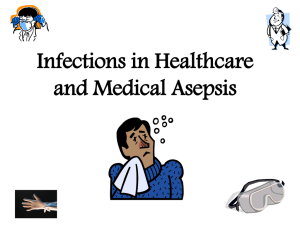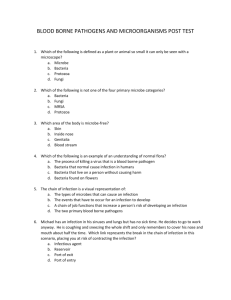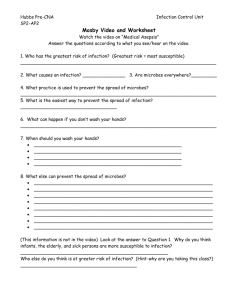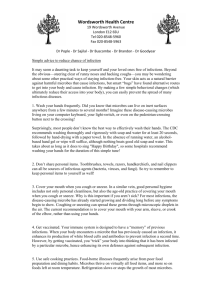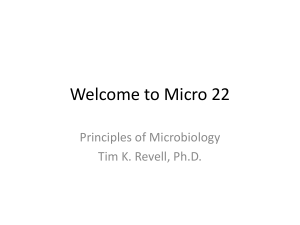Infections in Healthcare and Medical Asepsis Infection Infection
advertisement
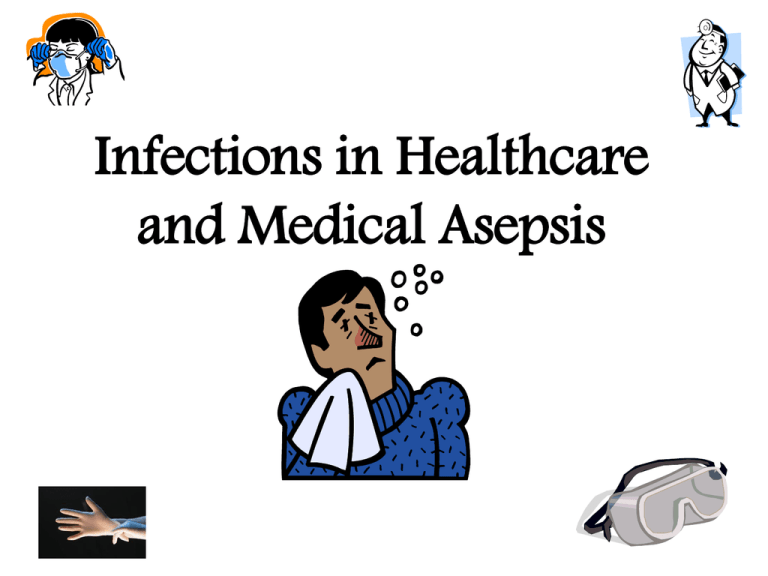
Infections in Healthcare and Medical Asepsis Infection • Infection - invasion of the body by pathogenic microorganisms • Examples of microorganisms that can become pathogenic (cause disease) – bacteria, virus, fungi, protozoa … • Local infection - one body part • Systemic infection - whole body • The passage of micro-organisms from one person to another Cross-Infection • Passage ofCross-Contamination microorganisms from one person or inanimate object to another Most common infections • Respiratory tract infections (cold, pneumonia, bronchitis, influenza) • Urinary tract infections (UTIs) • Gastrointestinal infections (nausea or diarrhea) • Skin infections (wound or IV site infection) Infections in Healthcare Settings • Nosocomial infection: infection acquired after admission to a health care facility - microbes can enter body through equipment used in treatments,therapies and tests (equipment must be free of pathogens) The Chain of Infection Chain of Infection 1) Infectious Agent (Pathogen): a microbe that is capable of causing disease 2) Reservoir: the environment where the pathogen lives before it infects 3) Portal of Exit: the path by which the pathogen leaves the reservoir 4) Mode of Transmission: how the pathogen travels from the portal of exit to the next reservoir or host 5) Portal of Entry: where the pathogen enters the new host’s body 6) Susceptible Host: person at risk for infection Microbe • A living creature that is too small to be seen with the naked eye Normal Flora Microbes that naturally live and grow in a certain location - they are harmless or even beneficial when they are in or on their natural location 1st STEP IN THE CYCLE OF INFECTION INFECTIOUS AGENT Pathogen • Disease-causing micro-organisms. • A small number of microbes are pathogenic. Bacteria • A one-celled microbe. Beneficial bacteria can help to sustain life and harmful bacterial can cause illness or death. Most bacteria are beneficial and help by fighting pathogenic microbes (infection causing) • There are about 300 different types of bacteria in our mouth alone! Bacteria Naturally occurring single-celled microbes that multiply rapidly infections caused by bacteria are usually treated with antibiotics Aerobes • A type of bacteria that requires oxygen to grow (ie. staphylococcus species) Anaerobes • A type of bacteria that grow in the absence of oxygen and are destroyed by oxygen (ie. clostridium – botulism) Facultative Anaerobes • Organisms that can grow in either the presence or the absence of oxygen. (ie. listeria and e coli) Bacteria Examples E. Coli Listeria Bacteria Examples E. Coli May, 2000 Bacteria Examples 2008 Listeria Virus • A type of infectious agent that is not bacterial. • Viruses are very tiny and must get inside a cell in order to grow and multiply. • They are very resistant to death and are capable of mutation. Viruses Non-living microbes that grow ONLY inside living cells They take over a cell’s machinery to produce new virus particles Antibiotics are NOT effective against viruses Some viral diseases can be prevented by vaccination Viruses Herpes Virus Human Papillomaviru Fungi Plants that lack chlorophyll, such as mushrooms, yeasts, and moulds. Fungi Microbes that live ONLY on organic matter (i.e. Plants or animals) Certain types of yeasts and moulds are common fungi that can be pathogens Fungi Athlete’s Foot Oral Fungus Protozoa • Single-celled, microscopic animals without a rigid cell wall. • They cannot live on their own as they require a vector to be spread from one place to the next. 2nd STEP IN THE CYCLE OF INFECTION HOST/RESERVOIR Host/Reservoir • A living organism from which a foreign organism obtains nourishment and protection. 3RD STEP IN THE CYCLE OF INFECTION PORTAL OF EXIT (Think openings of/on the body) 4th STEP IN CYCLE OF INFECTION MODES OF TRANSMISSION Modes of Transmission • Contact : physical touch (direct or indirect) • Droplet: microbes are spread short distances (less than 1 meter) in the air by droplets – coughing, sneezing and talking • Airborne: microbes are transmitted long distances (greater than 1 meter) by air currents • Vehicle: microbes are transmitted by a contaminated source (vehicle) – ex. food, water, medication and invasive medical equipment. • Vector-borne : insects or pests transmit microbes to humans 5TH STEP IN THE CYCLE OF INFECTION – PORTAL OF ENTRY PORTAL OF EXIT (Think openings of/on the body) 6TH STEP IN THE CYCLE OF INFECTION SUSCEPTIBLE HOST (Those who are prone to being infected) Factors that increase the risk of infection: • • • • • • • Young and old are at risk Poor nutrition Lack of sleep The presence of disease or illness Certain medication Invasive procedures Open wounds Preventing infections in healthcare settings: • Medical asepsis • Isolation precautions • Surgical asepsis Medical Asepsis • State of being free of pathogens (asceptic technique reduces the number of microbes) • Prevents the spread of microbes from one person/place to another person/place • Breaks the chain of infection Asceptic Practices • • • • • Hand Washing Sanitizing Disinfection Sterilization Controlling reservoirs, portals of exit/entry, transmission, and protect the susceptible host • Wearing your PPEs (gloves, masks, protective apparel, eye protection, face shield) • Proper disposal and bagging of PPEs OSHA • Federal regulations related to infection control and asepsis were developed by the Department of Labor’s Occupational Safety and Health Administration (OSHA) • These laws protect health-care workers from health hazards on the job, particularly from accidentally acquiring infections and health hazards patients and any other people who may come into the medical office The following must be discarded in a biohazardous waste container • • • • • blood products body fluids human tissues Vaccines table paper, linens, towels, and gauze with body fluids on them • Used scalpels, needles, sutures with needles attached, and other sharp instruments • Used gloves, disposable instruments, cotton swabs, and disposable applicators OSHA laws ensure • That proper measures are taken to prevent infection • Provide a margin of safety, • Ensure that a medical facility meets at least the minimal criteria for asepsis • These laws include: requirements for training personnel, keeping records, housekeeping, wearing protective gear OSHA divides tasks into 3 categories • Category I – tasks that expose a worker to blood, body fluids, or tissues or those that have a chance of spills or splashes. *These tasks always require specific protective measures • Category II – minimal risk of exposure ex. administering nose drops (hand washing) • Category III – tasks that do not require any special protection (ex. talking to the patient) Standard vs Universal Precautions • Standard Precautions are used in hospitals • Universal Precautions are used in medical offices What is WHMIS ? The Workplace Hazardous Materials Information System (WHMIS) is Canada's hazard communication standard. What are the main parts of WHMIS? The main components of WHMIS are: hazard identification and product classification labeling material safety data sheets, and worker training and education Why was WHMIS created? It was created in response to the Canadian workers' right to know about the safety and health hazards that may be associated with the materials or chemicals they use at work. The 6 WHMIS classes: 1. Compressed gas 2. Flammable and Combustible material 3. Oxidizing material 4. Poisonous and Infectious materials – Materials Causing Immediate and Serious Toxic Effects – Materials Causing Other Toxic Effects – Biohazardous Infectious Material 5. Corrosive material 6. Dangerously Reactive material
